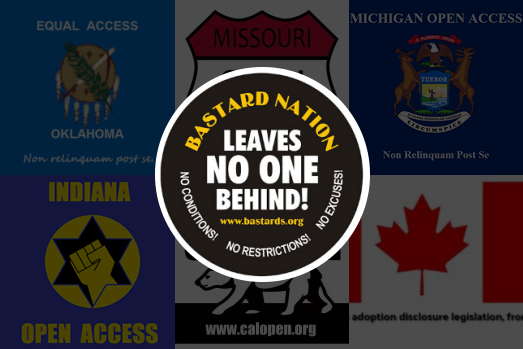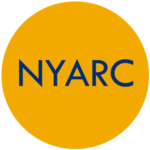Letter Written By Joan P. Brooks – one of the people responsible for opening Alaska’s laws.
September 24,1994
To: The Members of the Senate and General Assembly of the State of New Jersey
Dear Legislator:
As State Registrar of Vital Statistics for Alaska, I have been
approached by concerned people in a number of states asking for information
about experience in Alaska in opening adoption records. I hope that what I
have to offer will help in making some very important decisions in New
Jersey.
When Alaska achieved statehood in 1959, there was a regulation
already in place which directed that when a new certificate of birth has
been established after an adoption, the original record of birth is sealed
away from inspection except by order of a superior court, but that the
state registrar could open all or part of such sealed file for inspection
by the person whose record it is; if of legal age, by an agent of the state
or federal government acting in the performance of official duties, or for
any necessary administrative purpose within the bureau.
The word Inspection in the above paragraph caused me great concern
because most of the requests from adoptees for information came from “down
below’ which is how we refer to the contiguous United States. It seemed
quite improbable that the adoptees contacting me would be in any position
to visit me in Juneau to inspect the contents of a sealed file. Therefore,
I asked for an opinion from the Attorney General in 1979. The response that
I received gave me the advice that I needed which was that a photocopy of
the original birth record should be provided to a requesting adult adoptee
as long as the record was clearly noted that it was no longer a legal
record because a new certificate of birth had replaced it. That resolved my
dilemma until 1981 when a question was posed that we could not answer.
While we had the regulation which described what we could do and how to do
it, we were asked to identify the specific law under the Vital Statistics
Act of Alaska Statutes which authorized us to act upon and carry out the
regulation. We found that we were lacking the statutory authority.
Several legislators were approached about proposing a bill that
would authorize by statute what we were already doing by regulation. That
seemed rather straight forward but, In 1981, a bill was drafted that was
very complex indeed. It provided a means for adult adoptees to request
access to their original birth certificates.
However, that request would have set in motion a cumbersome and
costly set of procedures making the department responsible for attempting
to contact the biological parents to inform them of the request and of
their right to either consent to the disclosure or to file a statement that
the information not be disclosed. The contacts could not be made by mail,
only in person, meaning exorbitant travel mostly outside of Alaska. If the
department was not able to contact the biological parents within six months
after the initial request from the adoptee, and the biological parent or
parents had not flied regarding disclosure, the state registrar would
release the information to the adopted person. That bill also provided for
disclosure by the court if it was determined that such disclosure would be
of greater benefit than non-disclosure.
The Alaska Department of Health & Social Services opposed that bill
as written. I testified before several senate legislative committees that
such a law would be very costly because of the difficulty in locating birth
parents 18 or more years after the birth. I emphasized that what I had been
doing by regulation for years could be easily incorporated into the
statutes. The bill provided that the department could request a child
adoption agency to assist in the search of biological parents, but it did
not recognize the fact that the majority of adoptions in Alaska were not
handled by adoption agencies. About 70 percent of adoptions are handled by
attorneys or physicians, but they were not included in the bill as a source
of assistance because it was not likely that they would be willing to help.
The bill also called for the collection of information regarding
each biological parent including age, heritage, education, physical
appearance, talents, hobbies, interests, existence of other children,
religion, occupation, health history, plans made for the adopted person’s
future, the legal relationship between the biological parents and the
reason for the placement for adoption. We very much objected to the last
three categories of information. In our fiscal note we estimated that the
cost of this legislative change would be (in thousands) $83.3 in FY82,
$168.2 in FY83, $198.9 in FY84, $227.5 in FY85 and $260.6 in FY86. These
costs related mostly to the search for and travel to locate the parents.
The bill went through more review and revisions, but was never passed out
of either the judiciary or the health, education and social services
committee. It was held over until the second session of the Twelfth
Legislature in 1982 where it was bogged down because of the fiscal note and
the objection to the personal contact with the birth parents. When the i982
session ended, that bill died.
Still, the battle was far from over. In 1983, a new bill was
entered which addressed the collection of information about an adoptee’s
biological parents only and did not speak to access of the file by the
adult adoptee. That bill became buried in the house and subsequently died,
only to be followed by a new version in 1984 in the senate, which attempted
again to resolve the question of consent by the biological parents. The
1984 version called for notice by certified mail to the addressee only, at
the last known address. That version gave me even more heartburn because
few residence addresses from birth records are still valid more than 18
years after the fact. So, again I testified that the bill should sanction
by statute what we had been doing successfully for so many years.
My reason for going Into such a lengthy review of our experience in
Alaska is to demonstrate that from 1981 until 1986 we spent long, long
hours seemingly trying to push through a bureaucratic monster. Alter 5
years it appeared that unless the bill was costly, irritating and
cumbersome, it would not pass one body let alone both the house and the
senate. Then, in 1986, reason took over and a bill was drafted encompassing
only what we needed, and I gave my wholehearted support. Since then, I am
happy to report that we have had very good results. Even though we can
provide only an uncertified copy of the original birth record and what
little else might be in the sealed file, the process has been well
received.
While it is true that some of the adoptees ask us to find a parent
or brothers and sisters, they accept our explanation that we are not
permitted to do that. However, every time an adult adoptee or a birth
parent contacts us, we always make sure to suggest that they write a
letter, seal It In an envelope and send it to me to place in the file.
Then, when I hear from the adoptee or the parent, I can offer the letter
and let them take it from there. When a parent or adoptee gives me a letter
in a sealed envelope to place in the file, I ask for a short, hand-written
note of instruction that if information is requested. I should offer the
letter. We have had wonderful success with that and a number of very happy
reunions.
In doing this for 15 years and during all that testifying before
finally getting our bill, I heard from many adoptees, birth parents and
adoptive parents in support of the things we were doing. Only one birth
parent has ever contacted me to object to what we are doing. When I told
her that I fully understood her position, but that I could not refuse to
open the file if her child ever contacted me, I suggested that she contact
a superior court judge and have an order issued restraining me from opening
the file. That was at least 6 years ago and the order has not yet come.
Since February 1989 we have been keeping a tally of the number of
contacts we receive from adult adoptees and birth parents. For the 11
months left in 1989, we had 85 letters of request. In 1990, there were 124
and in 1991 there were 141 contacts to this office. So far in 1992, we have
had 114 requests; Indicating that 1992 will result in at least 160 or more
requests for access. Again I would like to emphasize that these were all
satisfying and pleasant contacts, with no adverse comments or results,
which I feel Is very Important in evaluating the merits of opening adoption
files. I assure you that if I felt or knew of any negative aspects, I would
certainly report them. What we are doing is just another function of our
adoption unit, so there was no additional cost to our operation in terms of
personnel.
I hope that the experiences with adoptions In Alaska will be of
assistance to you in your efforts. This is truly a worthwhile program for
the clients we serve. and if my impressions on the subject generate
questions or concerns I will be happy to discuss the matter further.
Sincerely,
Joan P.Brooks
State Registrar of Vital Statistics




